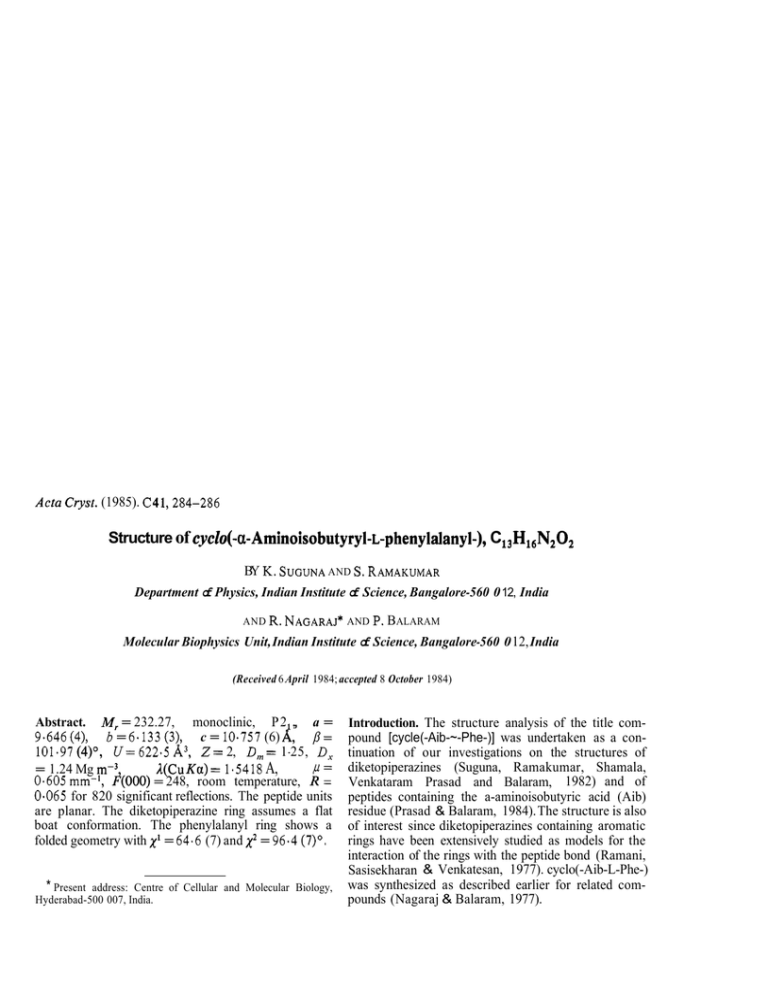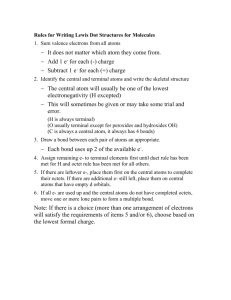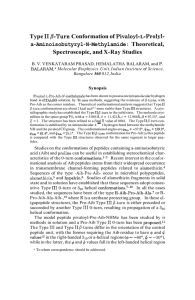s. 13H16N202 of
advertisement

Acta Cryst. (1985). C41,284-286 Structure of cycZo(-a- Aminoisobutyryl-L-phenylalanyl-), C13H16N202 BY K. SUGUNA AND s. RAMAKUMAR Department of Physics, Indian Institute of Science, Bangalore-560 0 12, India AND R. NAGARM*AND P. BALARAM Molecular Biophysics Unit, Indian Institute of Science, Bangalore-560 0 12, India (Received 6 April 1984; accepted 8 October 1984) Abstract. Mr = 232.27, monoclinic, P2 , a = 9.646 (4), b = 6.133 (3), c = 10.757 (6) p= 101.97 (4)", U = 622-5 A3, 2 = 2, D, = 1-25, D, = 1.24 Mg m-3, d(Cu K a ) = 1.5418 A, P= 0.605 mm-', F(000) = 248, room temperature, R = 0.065 for 820 significant reflections. The peptide units are planar. The diketopiperazine ring assumes a flat boat conformation. The phenylalanyl ring shows a folded geometry with x1= 64.6 (7) and x2 = 96.4 (7)O. A, * Present address: Centre of Cellular and Molecular Biology, Hyderabad-500 007, India. Introduction. The structure analysis of the title compound [cycle(-Aib-~-Phe-)] was undertaken as a continuation of our investigations on the structures of diketopiperazines (Suguna, Ramakumar, Shamala, Venkataram Prasad and Balaram, 1982) and of peptides containing the a-aminoisobutyric acid (Aib) residue (Prasad & Balaram, 1984). The structure is also of interest since diketopiperazines containing aromatic rings have been extensively studied as models for the interaction of the rings with the peptide bond (Ramani, Sasisekharan & Venkatesan, 1977). cyclo(-Aib-L-Phe-) was synthesized as described earlier for related compounds (Nagaraj & Balaram, 1977). Experimental. Crystals were grown by controlled diffusion of ethyl acetate into saturated methanol solution. D, by flotation in CCl,/hexane. Space group and cell parameters determined by rotation and Weissenberg methods; cell dimensions refined by least squares using 25 high-angle reflections on a Nonius CAD-4 diffractometer. Intensity data collected on the diffractometer with w-20 scans using graphite-monochromated Cu K a radiation. Crystal 0.05 x 0.08 x 1.43 mm. Omax= 60". Two standard reflections (103 and 113) monitored at regular intervals, crystal stable to X-rays. Intensities not corrected for absorption @r e 0.05). Out of 915 unique reflections measured up to 8= 60°, 820 considered significant [ IF1 2 2 4 IFI)].Index range h k 10, k 0/6,10/12. Structure solved using MULTAN80 (Germain, Main & Woolfson, 1971; P. Main, 1980, private communication). The E map calculated with the phases corresponding to the best set revealed six atoms of the diketopiperazine ring. Karle recycling (Karle, 1968) with these atoms gave the other 1 1 nonhydrogen atoms. Full-matrix least-squares refinement on F (SHELX76, Sheldrick, 1976) with positional and isotropic temperature factors of non-H atoms converged at R = 0.13; inclusion of anisotropic temperature factors reduced R to 0.087. At this stage all the H atoms could be located from a difference map. R reduced to 0-065 when the refinement was carried out with i.nclusion of the H atoms in the structure factor calculation and with an individual weight, w cc l/02(lFl). H-atom positions were not refined. All H atoms were given an isotropic temperature factor ( v ) of 0.050 A2. In the final cycle of refinement, A/a < 0.1 and wR = 0.071. Ap in final difference map within +0.3 and -0.3 e A-3. Discussion. Final parameters are listed in Table l.* Fig. 1 shows the cyclo(-a-aminoisobutyryl-L-phenylalanyl-) molecule with the numbering scheme. * Lists of structure factors, anisotropic thermal parameters, H-atom coordinates, bond distances and angles involving H atoms, torsion angles and Tables 3, 4 and 5 have been deposited with the British Library Lending Division as Supplementary Publication No. SUP 39813 (14 pp.). Copies may be obtained through The Executive Secretary, International Union of Crystallography, 5 Abbey Square, Chester CH 1 2HU, England. Table 2 lists the bond lengths, bond angles and selected torsion angles (IUPAC-IUB Commission on Biochemical Nomenclature, 1970) involving the nonhydrogen atoms, and also the hydrogen-bonding parameters involving the non-hydrogen atoms. The torsion angles cu,, cuz [-1.5 (9), -4.2 (lo)", Table 21 about the peptide bond show that the peptide units are nearly planar. Thus the peptide conformation compares more favourably with that of cyclo(-Gly-L-Trp-) (a+, w2 = 3, -3 ") (Morris, Geddes & Sheldrick, 1974) than Table 1. Fractional coordinates (x lo4) and equivalent isotropic temperature factors of non-H atoms with e.s.d.'s in parentheses Ueq= f.Ti,XjUija:aj*ai.aj. Y Z Ul2q(A2) -4452 2712 (8) -2932 (9) 1212 (9) -2807 (10) 1094 (1 1) -554 (1 1) -1144 (10) -1417 ( 1 1 ) -1273 ( 1 1) 704 (1 2) 851 (16) -900 (18) -2824 (15) -3032 (12) -296 ( 1 I ) -463 (12) 92 10 (4) 8266 (4) 8658 (4) 8859 (5) 8978 (6) 8499 (5) 9076 (6) 8342 (5) 6995 ( 6 ) 5972 (5) 5346 (6) 44 17 (6) 41 1 1 (6) 4752 (8) 5652 ( 6 ) 10431 (6) 81 10 (6) 0.053 (3) 0.044 (3) 0.033 (3) 0.037 (3) 0-034 (4) 0.030 (3) 0.036 (4) 0.028 (3) 0.042 (4) 0.039 (4) 0.055 (4) 0.065 (5) 0.074 (5) 0.075 (6) 0.057 (4) 0.050 (4) 0.050 (4) X 7024 (5) 9840 (5) 8944 (6) 7979 (6) 7693 (7) 9193 (7) 7026 (7) 9813 (6) 10078 (7) 8765 (6) 8408 (8) 7201 (9) 6279 (9) 6622 (10) 7866 (9) 6753 (7) 5645 (7) Table 2. Bond distances (A),bond angles ( O ) , selected torsion angles (") and hydrogen-bond geometry 1.250 (7) 1.324 (9) I .537 (9) 1.463 (8) 1.542 (9) 1.51 I (9) 1.470 (9) 1.521 (9) 1.226 (8) N(l)-C(l)-O(l) N(l)-C(l)-C(3) O(l)-C(l)-C(3) C(I2)-C(3)-C(13) C ( I)-C(3)-C( 12) C ( I)-C(3)-N(2) N(2)-C(3)-C( 13) N(2)-C(3)-C( 12) C(I)-C(3)-C(13) C ( I)-N( I)-C(4) C(2)-N(2)-C(3) N(2)-C(2)-C(4) N(2)-C(2)-0(2) C(2)-N(2) C(4)-C(5) C(5)-C(6) C(6)-C(7) C(7)-C(8) C(8)-C(9) C(9)-C(IO) C(lO)-C(11) C(6)-C(11) 122.8 (6) 119.1 (6) 118.1 (6) 110.3 (5) 108.2 (5) I 11.5 (5) 110.8 (5) 108.0 (5) 107.9 (5) 127.9 (5) 129.3 ( 5 ) 118.6 (6) 122.7 (6) C(3)-C(I)-N(I)-C(4) C ( I)-N( I)-C(4)-C(2) N( I)-C(4)-C(2)-N(2) C(4)-C(Z)-N(2)-C(3) C(Z)-N(2)-C(3)-C(I) N(2)-C(3)-C( I)-N( I ) -1.5 (9) 4.2 (9) - 1.4 (8) -4.2 (10) 6.7 (9) -3.6 (8) C(4)-C(2)-0(2) N(I)-C(4)-C(2) N( I)-C(4)-C(5) C(Z)-C(4)-C(5) C(4)-C(5)-C(6) C(5)-C(6)-C(7) C(5)-C(6)-C(I I ) C(7)-C(6)-C(I I ) C(6)-C( 1 I)-C( 10) C ( l I)-C(IO)-C(9) C(IO)-C(9)-C(8) C(9)-C(8)-C(7) C(8)-C(7)-C(6) Fig. 1. View of the molecule showing the folded geometry of the phenylalanyl residue. 118.7 (6) 113.2 (5) 110.7 (5) 110.5 (5) 114.0 (5) 119.5 (6) 121.9 (6) 118.6 (6) 120.7 (7) 121.0 (8) 118.0 (8) 121.8 (8) 119.7 (7) C(I)-N(I)-C(4)-C(5) -120.5 (7) 123.4 (6) N(Z)-C(Z)-C(4)-C(S) 64.6 (7) N(I)-C(4)-C(5)-C(6) C(2)-C(4)-C(5)-C(6) -61.7 (7) -81.6 (8) C(4)-C(5)-C(6)-C( 1 1 ) 96.4 (7) C(4)-C(5)-C(6)-C(7) Hydrogen-bonding geometry N(l)-H(l)...O(2') N(2)-H(2)...0( I") 1.309 (9) 1.532 (8) 1.498 (9) 1.395 (10) 1.371 (10) 1.390 (14) 1.372 (14) 1.382 (12) 1.382 (10) N...O 2.866 (6)A 2.865 (7) Symmetry code: (i) x, 1 - y, z ; (ii) x, I + y. z. with that of cycle(-Gly-L-Tyr-) (al, w2 = -4, -7O) (Lin & Webb, 1973). The torsion angles 9, ty and a of the peptide backbone [V)Aib = 6.7 (g), YAib = -3.6 (8), WAib = -1.5 (91, pphe = 4.2 (g), Wphe = -1.4 (8), U p h e = -4.2 (lo)"] (Table 2) indicate that the diketopiperazine ring assumes a flat boat conformation. The bond lengths (Table 3, deposited) and bond angles (Table 4, deposited) of the Aib residue compare well with those found in cyclo(-Aib-Aib-) and cyclo(-Aib-L-isoleucyl-) (Suguna et al., 1982). The bond angle (7,) in these three compounds [129-3 (6), C"-N-C' 130.1 (3) and 127.9 (7)O], however, is significantly greater than the average value (122.1O) found in Aib-containing linear peptides (Paterson, Rumsey, Benedetti, Nemethy & Scheraga 1981). This feature is observed in many cyclic dipeptides, e.g. cycle(-GlyGly-) (126-0O) (Degeilh & Marsh, 1959), cyclo(-D-Ala-L-Ala-) (127.9O) (Sletten, 1970), cyclo(-L-AlaL-Ala-) (126.2, 125.2") (Sletten, 1970), cycle(-GlyL-Tyr-) (126.0, 126.9O) (Lin & Webb, 1973) and cycle(-L-Ser-L-Tyr-) (128.3, 1 2 7 0 4 ~ (Lin ) & Webb, 1973). The molecule is in a folded conformation as shown in Fig. 1. The phenylalanyl C" atom occupies an axial position with x1= N(l)-C(4)-C(5)-C(6) = 64.6 (7) = 96.4 (7)O. These and x2 = C(4)-C(5)-C(6)-C(7) values are in good agreement with those corresponding to the theoretically calculated minimum-energy conformation for the Phe residue (jyl = 60, x2 = 90°) (Caillet, Pullman & Maigret, 1971; Chandrasekaran, Lakshminarayanan, Mohanakrishnan & Ramachandran, 1973). The folded conformation for the molecule is consistent with the situation observed in other diketopiperazines containing the phenylalanyl and tyrosyl residues (Table 5, deposited), such as cyclo(-L-Pro-L-Phe-) (Ramani, Venkatesan, Marsh & Hu Kung, 1976), cycZo(-N-Me-L-Phe-N-Me-D-P he-) O c L Q b 0 Q Fig. 2. Packing of the molecules viewed down the a* axis. (Benedetti, Marsh & Goodman 1976), cyclo(-GlyL-Tyr-) (Lin & Webb, 1973) and cycZu(-L-Ser-L-Tyr-) monohydrate (Lin & Webb, 1973). However, in the case of cycle(-N-Me-L-Phe,-) (Benedetti et al., 1976) one of the phenylalanyl rings folds over the diketopiperazine ring whereas the other is forced away from this ring to avoid steric repulsions. In the solid-state conformation, one of the Aib CH, groups is located close to the phenyl ring [C(13) is 4.07 A from the midpoint of the benzene ring]. The 100MHz lH NMR spectrum of cycZo(-Aib-L-Phe-) in trifluoroacetic acid solution reveals a large chemical shift difference of 0.69 p.p.m. between the two Aib CH, groups. The abnormally high field resonance at 0.88 p.p.m. (from tetramethylsilane reference) is due to the CH, group proximal to the benzene ring. This suggests that the folding pattern of the Phe side chain observed in the crystal structure is maintained in solution. The crystal structure is stabilized by N-H...O hydrogen bonds (Fig. 2). Each molecule forms a pair of hydrogen bonds to adjacent b-translated molecules (Table 2). The hydrophobic and hydrophilic groups are neatly segregated into adjacent layers parallel to the c axis. KS and SR thank Professor M. A. Viswamitra for encouragement and facilities for carrying out the work. References BENEDETTI, E., M ARSH , R. E. & GOODMAN, M. (1976). J . Am. Chem. SOC.98,6676-6684. C AILLET , J., PULLMAN, B. & MAIGRET, B. (1971). Biopolymers, 10, 22 1-224. C HANDRASEKARAN , R., L AKSHMINARAYANAN , A. V., M OHANAKRISHNAN , P. & R AMACHANDRAN , G. N. (1973). Biopol-vmers, 12,142 1-1425. D EGEILH , R. & M ARSH , R. E. (1959). Act0 Cryst. 12, 1007-1014. G ERMAIN , G.,M AIN , P. & WOOLFSON, M. M. (1971). Acta Cryst. A21,368-376. IUPAC-IUB C OMMISSION ON B IOCHEMICAL NOMENCLATURE ( 1970). Biochemistry, 9,347 1-3479. K ARLE , J. (1968). Acta Cryst. B24, 182-186. L IN , C. F. & W EBB , L. E. (1973). J. Am. Chem. SOC. 95, 6803-68 1 1. M ORRIS , A. J., G EDDES , A. J . & SHELDRICK, B. (1974). Cryst. Struct. Commun. 3,345-349. N AGARAJ , R. & BALARAM, P. (1977). Heterocycles, 7,885-890. PATERSON, Y., R UMSEY , S. M., BENEDETTI, E., NEMETHY, G. & SCHERAGA, H. A. (1 98 1). J. Am. Chem. SOC.103,2947-2955. P RASAD , B. V. V. & BALARAM, P. (1984). Crit. Rev. Biochem. 16, 307-348. R AMANI , R., S ASISEKHARAN , V. & VENKATESAN, K. (1977). Int. J. Pept. Protein Res. 9, 277-292. R AMANI , R., V ENKATESAN , K., M ARSH , R. E. & Hu K UNG , W. J. (1976).Acta Cryst. B32,1051-1056. S HELDRICK , G . M. (1976). SHELX76. Program for crystal structure determination. Univ. of Cambridge, England. SLETTEN, E. (1970). J . Am. Chem. SOC.92,172-177. S UGUNA , K., R AMAKUMAR , S., SHAMALA, N., VENKATARAM PRASAD, B. V. & BALARAM, P. (1982). Biopolymers, 21, 1847-1855.








